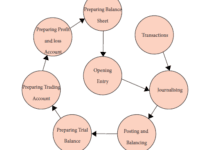Are you learning accounts? Have you ever puzzled after looking at the financial statements of a company? In this post, you will learn some key terms that will ease your understanding of accounting and Profit & Loss, Balance sheet.
Entity
Entity means a reality that has a definite individual existence. Business entity means a specifically identifiable business enterprise like Departmental Stores, Jewellers, BHEL Limited, etc. An accounting system is always devised for a specific business entity (also called an accounting entity).
Transaction
An event involving some value between two or more entities. It can be a purchase of goods, receipt of money, payment to a creditor, incurring expenses, etc. It can be a cash transaction or a credit transaction.
Assets
Assets are the economic resources of an enterprise that can be usefully expressed in monetary terms. Assets are items of value used by the business in its operations. For example, a Logistics company owns a fleet of trucks, which is used by it for delivering goods; the trucks, thus, provide economic benefit to the enterprise. This item will be shown on the asset side of the balance sheet of the Logistics company. Assets can be broadly classified into two types: current and Non-current.
Liabilities
Liabilities are obligations or debts that an enterprise has to pay at some time in the future. They represent creditors’ claims on the firm’s assets. Both small and big businesses find it necessary to borrow money at one time or the other and to purchase goods on credit. Departmental Store, for example, purchases goods for Rs.1,00,000 on credit for a month from XYZ Foods on March 25, 2021. If the balance sheet of Departmental Store is prepared as of March 31, 2021, XYZ Foods will be shown as creditors on the liabilities side of the balance sheet. If Departmental Store takes a loan for a period of three years from SBI Bank, this will also be shown as a liability in the balance sheet of Departmental Store. Liabilities are classified as current and non-current
Capital
Amount invested by the owner in the firm is known as capital. It may be brought in the form of cash or assets by the owner for the business entity capital is an obligation and a claim on the assets of the business. It is, therefore, shown as capital on the liabilities side of the balance sheet.
Sales
Sales are total revenues from goods or services sold or provided to customers. Sales may be cash sales or credit sales.
Revenues
These are the amounts of the business earned by selling its products or providing services to customers, called sales revenue. Other items of revenue common to many businesses are commission, interest, dividends, royalties, rent received, etc. Revenue is also called income.
Expenses
Costs incurred by a business in the process of earning revenue are known as expenses. Generally, expenses are measured by the cost of assets consumed or services used during an accounting period. The usual items of expenses are depreciation, rent, wages, salaries, interest, cost of heater, light and water, telephone, etc.
Expenditure
Spending money or incurring liability for some benefit, service or property received is called expenditure. Purchase of goods, purchase of machinery, purchase of furniture, etc. are examples of expenditure. If the benefit of expenditure is exhausted within a year, it is treated as an expense (also called revenue expenditure). On the other hand, the benefit of an expenditure lasts for more than a year, it is treated as an asset (also called capital expenditure) such as the purchase of machinery, furniture, etc.
Profit
The excess of revenues of a period over its related expenses during an accounting year is profit. Profit increases the investment of the owners.
Gain
A profit that arises from events or transactions which are incidental to business such as the sale of fixed assets, winning a court case, appreciation in the value of an asset.
Loss
The excess of expenses of a period over its related revenues is termed as a loss. It decreases in owner’s equity. It also refers to money or money’s worth lost (or cost incurred) without receiving any benefit in return, e.g., cash or goods lost by theft or a fire accident, etc. It also includes a loss on sale of fixed assets.
Discount
Discount is the deduction in the price of the goods sold. It is offered in two ways. Offering deduction of an agreed percentage of list price at the time selling goods is one way of giving a discount. Such a discount is called ‘trade discount’. It is generally offered by manufacturers to wholesalers and by wholesalers to retailers. After selling the goods on a credit basis the debtors may be given a certain deduction in the amount due in case if they pay the amount within the stipulated period or earlier. This deduction is given at the time of payment on the amount payable. Hence, it is called a cash discount. Cash discount acts as an incentive that encourages prompt payment by the debtors.
Voucher
The documentary evidence in support of a transaction is known as a voucher. For example, if we buy goods for cash, we get a cash memo, if we buy on credit, we get an invoice; when we make a payment we get a receipt and so on.
Goods
It refers to the products in which the business unit is dealing, i.e. in terms of which it is buying and selling or producing and selling. The items that are purchased for use in the business are not called goods. For example, for a furniture dealer purchase of chairs and tables is termed as goods, while for
others it is furniture and is treated as an asset. Similarly, for a stationery merchant, stationery is goods, whereas for others it is an item of expense (not purchases)
Drawings
Withdrawal of money and/or goods by the owner from the business for personal use is known as drawings. Drawings reduce the investment of the owners.
Purchases
Purchases are the total amount of goods procured by a business on credit and on cash, for use or sale. In a trading concern, purchases are made of merchandise for resale with or without processing. In a manufacturing concern, raw materials are purchased, processed further into finished goods and then sold. Purchases may be cash purchases or credit purchases.
Stock
Stock (inventory) is a measure of something on hand goods, spares and other items in a business. It is called Stock in hand. In a trading concern, the stock on hand is the number of goods that are lying unsold as at the end of an accounting period is called closing stock (ending inventory). In a manufacturing company, closing stock comprises raw materials, semi-finished goods and finished goods
on hand on the closing date. Similarly, opening stock (beginning inventory) is the amount of stock at the beginning of the accounting period.
Debtors
Debtors are persons and/or other entities who owe to an enterprise an amount for buying goods and services on credit. The total amount standing against such persons and/or entities on the closing date is shown in the balance sheet as sundry debtors on the asset side.
Creditors
Creditors are persons and/or other entities who have to be paid by an enterprise an amount for providing the enterprise goods and services on credit. The total amount standing to the favour of such persons and/or entities on the closing date is shown in the Balance Sheet as sundry creditors on the liabilities side.



I read this accounting terms it’s Easy to understood
Glad to know that!